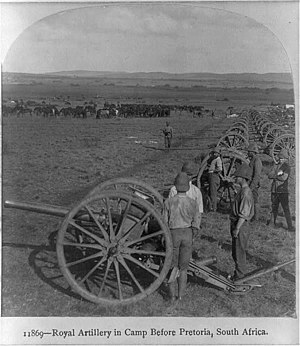Ordnance BL 15 pounder
| Ordnance BL 15 pounder | |
|---|---|

15 pounder in South Africa during the Second Boer War
|
|
| Type | Field gun |
| Place of origin | United Kingdom |
| Service history | |
| In service | 1892–1918 |
| Used by | British Empire |
| Wars |
Second Boer War World War I |
| Specifications | |
| Barrel length | 84 inch |
|
|
|
| Shell | Separate loading BL, 14 lb (6.4 kg) shrapnel |
| Calibre | 3 inch (76.2 mm) |
| Elevation | -5° - 16° |
| Rate of fire | 7-8 rds/min |
| Muzzle velocity | 1590 ft/s |
| Maximum firing range | 6000 yds |
The Ordnance BL 15 pounder, otherwise known as the 15 pounder 7 cwt, was the British Army's field gun in the Second Boer War and some remained in limited use in minor theatres of World War I. It fired a shell of 3-inch diameter with a maximum weight of 15 pounds (6.8 kg), hence its name which differentiated it from its predecessor "12 pounder" 3-inch gun which fired shells weighing only 12.5 pounds (5.7 kg).
The gun was a modified version of the previous BL 12 pounder 7 cwt gun of 1883. When the modern smokeless propellant cordite replaced gunpowder in 1892 it was decided that the 12 pounder was capable of firing a heavier shell up to 15 lb (6.8 kg). A 14 pound shell was adopted and the gun was renamed a 15 pounder.
Mk I carriage : recoil was controlled by drag-shoes. These were placed under the wheels, and were connected by chains and cables to the wheel hubs and the trail.
Mk II carriage : this had the same drag-shoe system and also a hydraulic buffer. This only allowed a short recoil, and was not successful.
Mk III carriage : In 1899 a rudimentary recoil system was added, consisting of a "spade" beneath the axle which dug in when the gun recoiled, connected by a steel wire to a spring in a cylinder on the trail. Mk I and II carriages fitted with these were known as Mk 1* and Mk II*. The latter retained the hydraulic buffer.
Although the whole gun jumped and moved backwards on firing, the spring returned it to firing position and hence still increased the rate of fire compared to the old model without any recoil mechanism. Hogg and Thurston comment ironically : "It is said that it checked it [recoil] so well that the gun usually recoiled 1 foot and jumped forward 2 feet".
Other Mks of carriage followed, all with axle-spades, but without buffers.
From 1904 the BL 15 pounder was superseded by the modern QF 18 pounder. Remaining BL 15 pounders were upgraded as the BLC 15 pounder to equip the Territorial Force with an "ersatz QF gun".
The gun was normally towed by 6 horses, in 3 pairs.
349 guns were in service in the Second Boer War 1899–1902 and fired 166,548 shells out of the British total of 233,714.
...
Wikipedia
